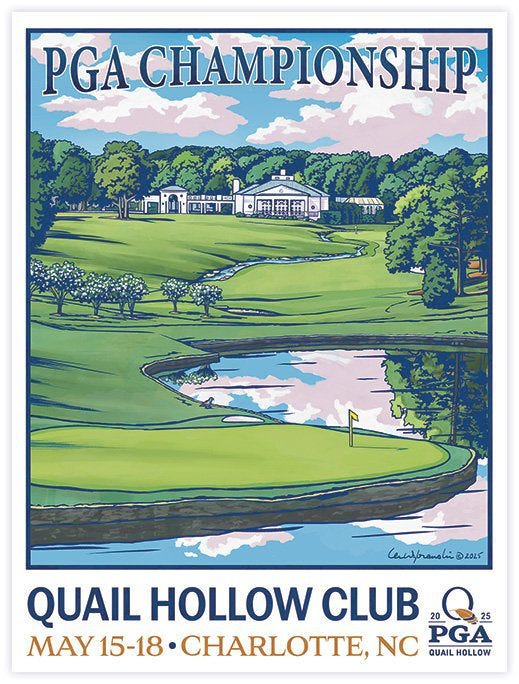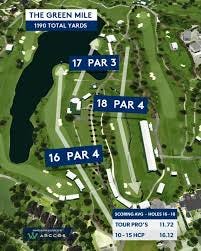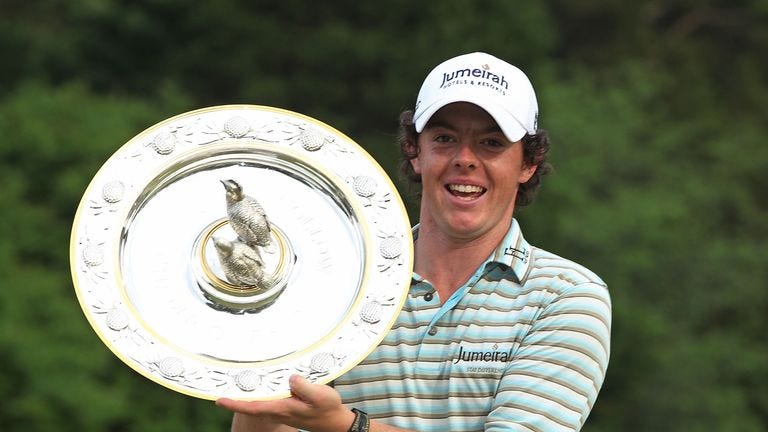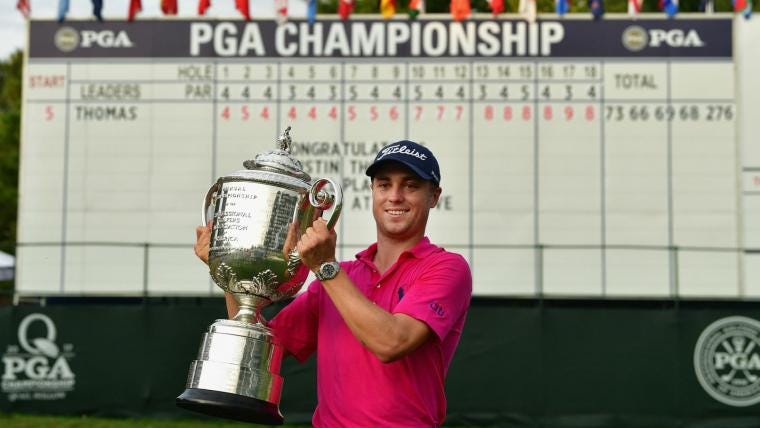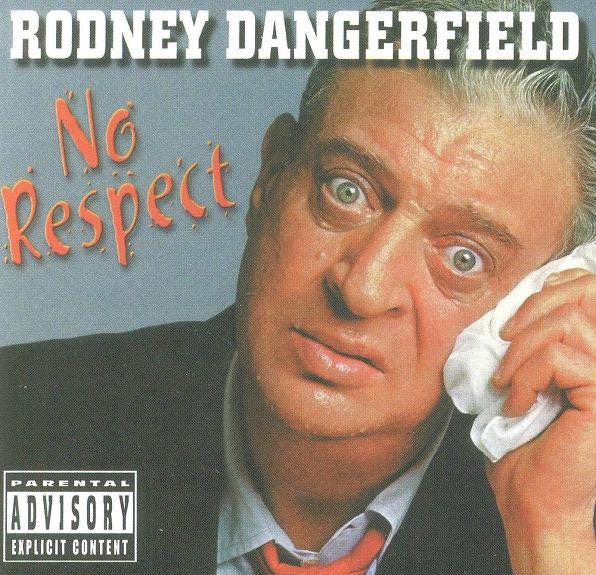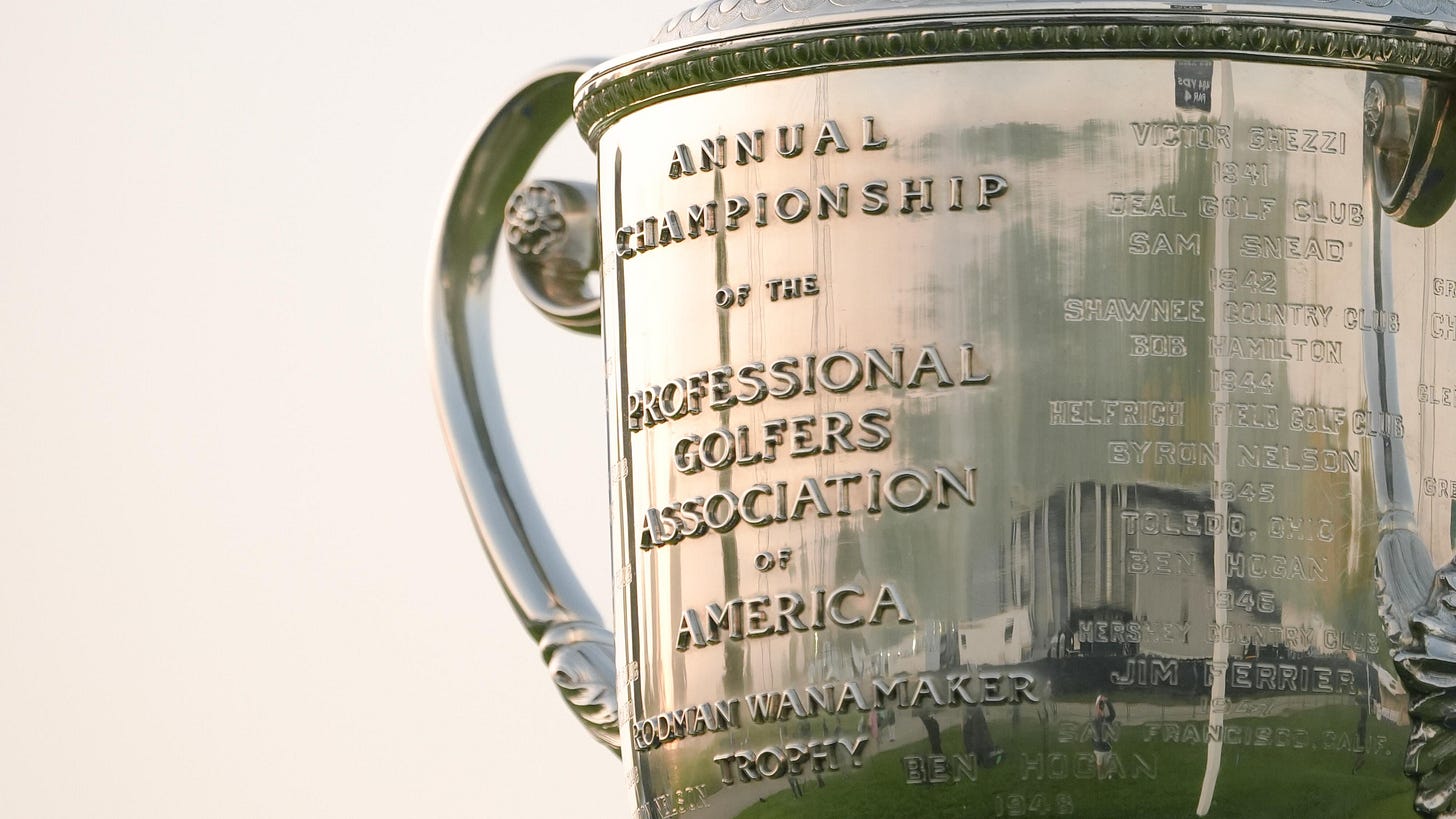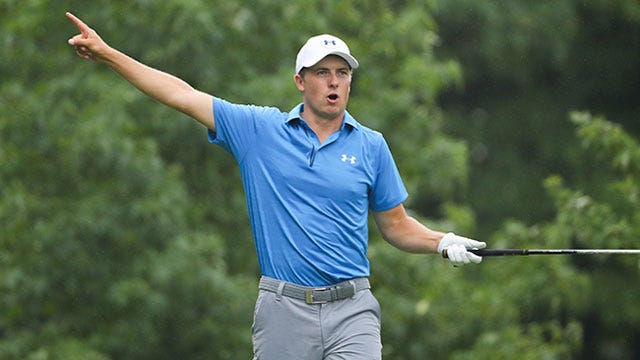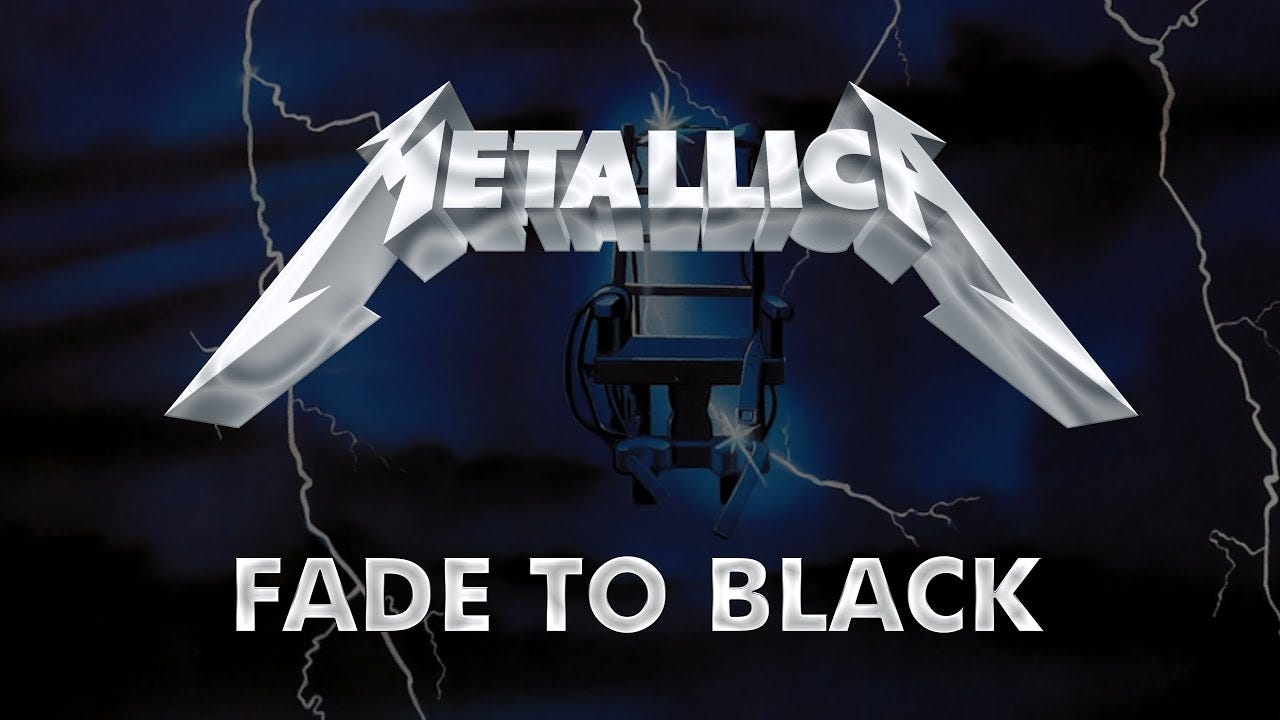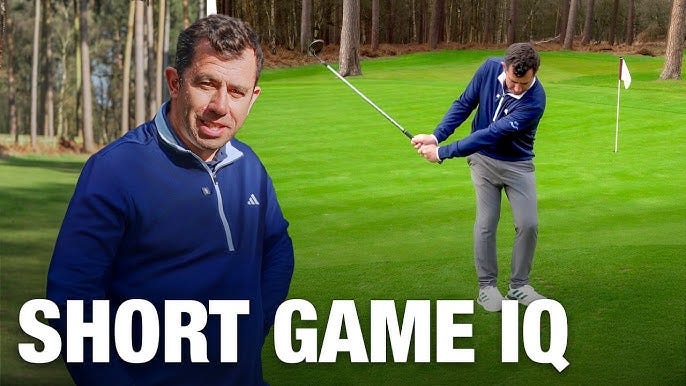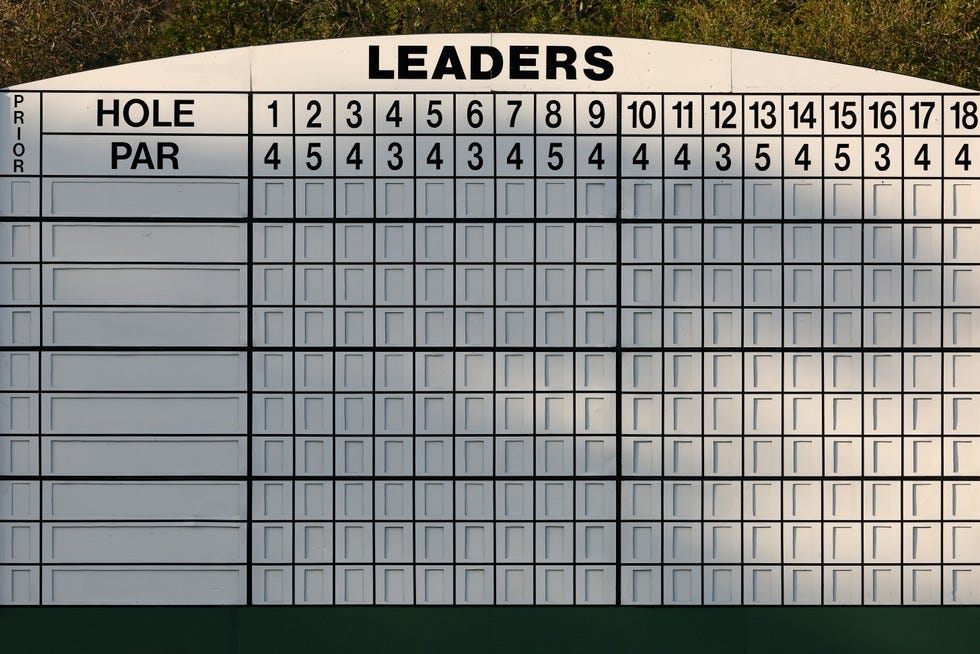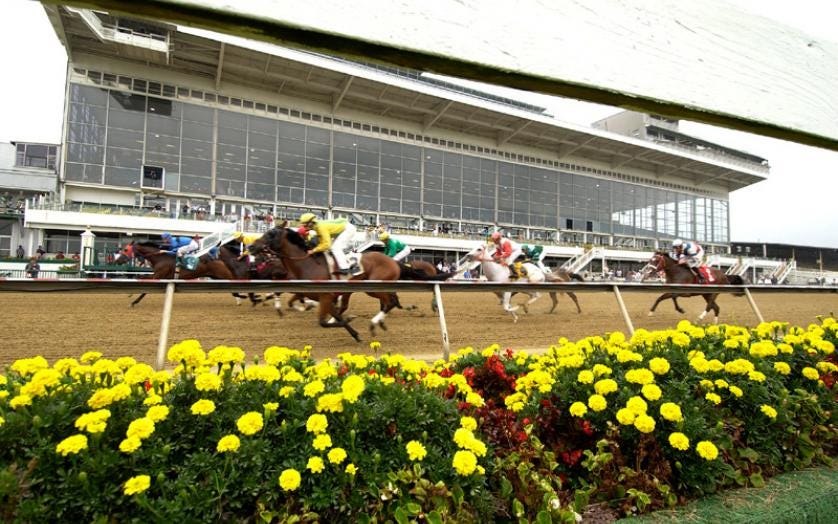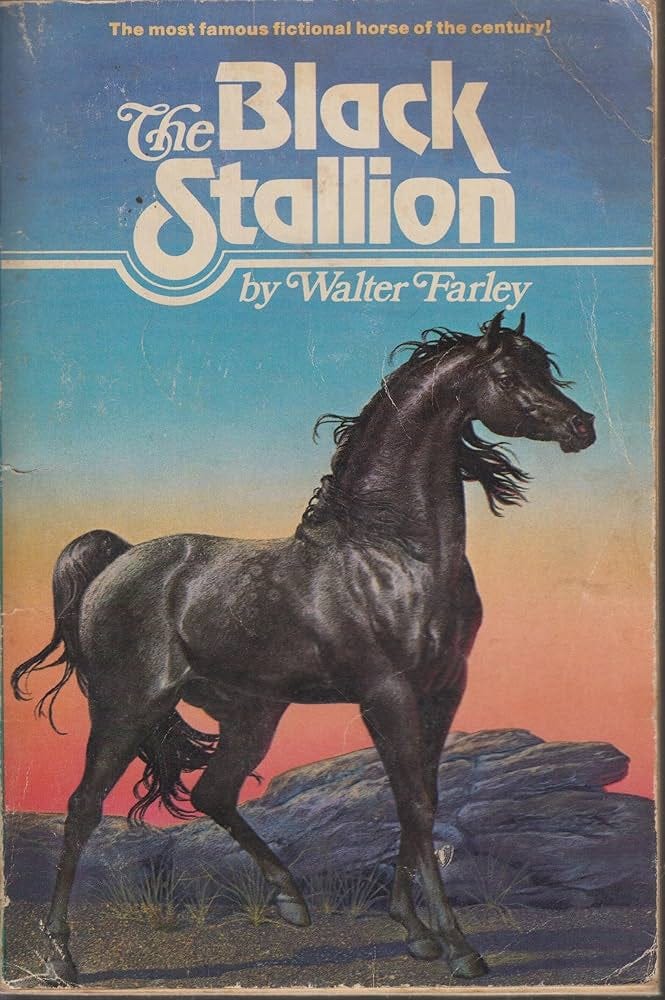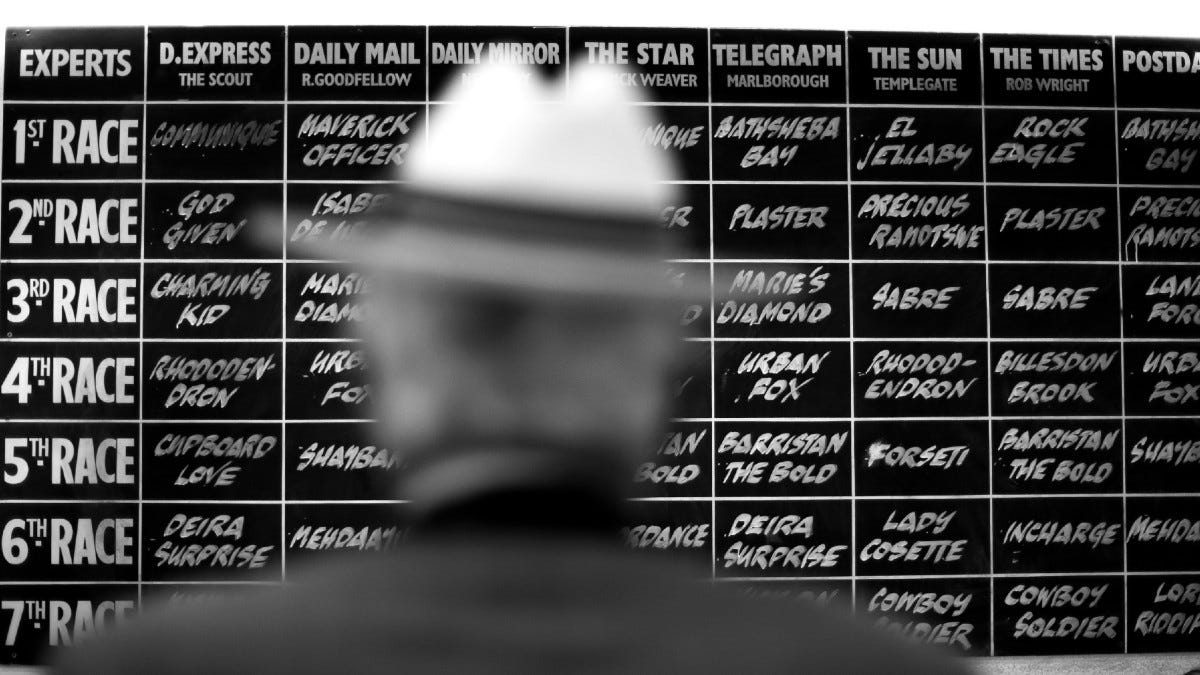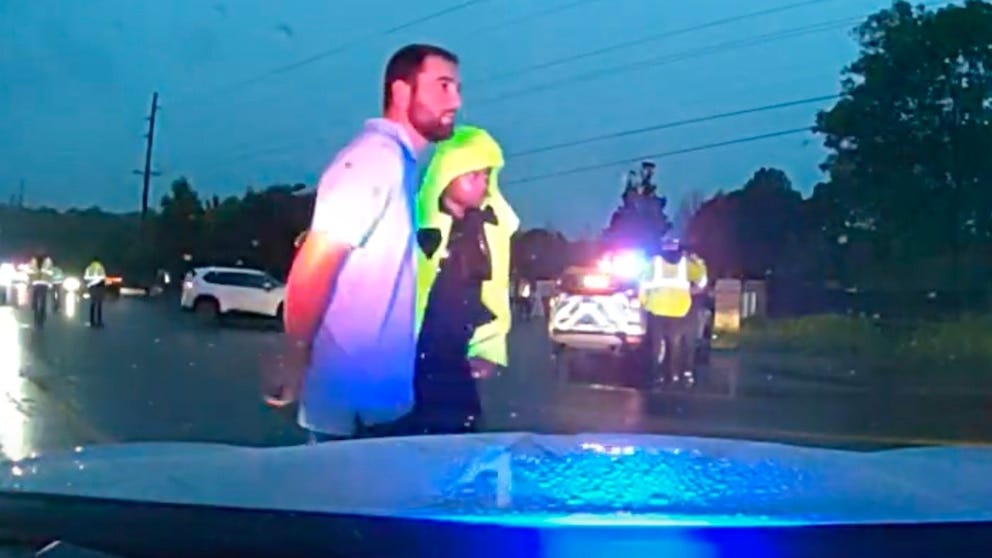Despite the enjoyment I had putting The Masters preview together (and how it was received) by ranking the Field from 95 to 1, we’ll pass on repeating that for the PGA Championship or the other two Majors. Mainly because it takes too long and I need much more prep time but also because these are full field events with nearly double the participants. So we’ll go back to the tried and true bullet point format numbering 18 to match the holes in a standard round.
1. Quail Hollow—a Pithy History
Quail Hollow is (surprise, surprise) a private club nearly 70 years old and likely the most prestigious in the Queen City of Charlotte. It was built on what was once the largest dairy farm in North Carolina. The club previously hosted the Kemper Open in the 70’s. After a sabbatical the Tour returned in 2003 for the Wachovia Championship and a half dozen bank mergers later is now known as the Truist.
Incidentally that particular Tour stop was last week and moved to Philadelphia Cricket Club in deference to this PGA Championship. That also happened when the course hosted its only other PGA in 2017 (more on that in a bit) although they went to Eagle Point Golf Club three hours south on the coast in Wilmington instead. Finally they moved it to TPC Potomac in 2022 for the Presidents Cup although no one remembers that or cares.
The course is your modern American standard of monstrous length at 7600+ yards1 and A to B to C target golf. Prior to the 2017 PGA the course underwent significant reimagining led by Tom Fazio who had began amendments to the layout as far back as 1993. The devil is in the details but essentially the 1st, 2nd, and 5th holes were redesigned, vertical edges were installed in the bunkers to mimic Royal Melbourne, and a forest of pines were felled. Finally a different strain of Bermuda called Champion G-12 was shipped in from Texas for green resodding after the previous Miniverde was found to be susceptible to splotchy mutation.2 Since 2017 even more renovations were employed most notably a ryegrass overseed to accommodate the new May location on the calendar.
Got all that? Course design and maintenance seems more trouble than it’s worth really but don’t tell the Fazio estate’s wealth manager.
Aesthetically, there is nothing that is going to stick to you, never mind take your breath away. It’s only made Golf Digest’s Top 100 twice best I can tell and near the rear both times. It is though a reasonable location for a PGA Championship even if its reputation among the players has waned in tandem with the changes since 2014. It wouldn’t be my first choice but they’ve taken this thing to worse places over the years. Southern Hills in Tulsa3 or Oakland Hills comes to mind. If compared to well known courses which have hosted Majors it probably reminds me of Baltusrol the most. Others have said Muirfield Village (which I personally don’t see at all), Bethpage Black or even the track I just dissed, Southern Hills.
2. The Green Mile
Quail Hollow does not have so much a signature hole but a signature stretch of them akin to “The Bear Trap” at PGA National, “The Snake Pit” at Innisbrook, and of course the much more heralded “Amen Corner” at Augusta National. Quail Hollow’s closing three holes as seen above have been dubbed “The Green Mile” and make no mistake are formidable with large numbers in play at either 16, 17, or 18. This is not going to be a Tournament where you can assume it’s over and power off your TV Sunday mid-afternoon regardless of the size of the lead. In the 2003 Wachovia David Toms had a 6 stroke lead on the 72nd tee and proceeded to make a quad 8. He still won but that gives you an idea of the uncertainty.
You are going to hear a lot about this analogized walk down death row4 all week so here is the skinny on the finishing three holes:
The 16th is a brutish par 4 of 529 yards after a new tee was added last year which brings the fairway bunker on the right into play even for the bombers. I should add it is downhill so I may be overdramatizing things. The green was moved 80 yards left in 2013 during some of the aforementioned Fazio tinkering to bring the existing lake more into play on approach. Even the players of today will be forced to play a middle iron into that protected green (at least I hope so).
On the par 3 17th the players will again be threatened with the water of that lake which surrounds the front and left side of the green nearly like a peninsula. Bailing out right is no help in most spots with the slope feeding imperfect chips to the fish. A longish par 3 at 220+ (for mortals) but also playing downhill it annually ranks in the top 5 most difficult holes on Tour. These guys will merrily take a 3 here every day and get the hell out of there.
The finisher is another par 4 that also won’t be driver-wedge for most guys at 494 yards and is the most difficult hole on the course statistically. There is a bunker on the right and yet more water down the entire left fairway all the way to the green in the form of a snaking creek, in play both off the tee and approach. I have seen observations that this hole is fairly mundane from a strategic point of view and they aren’t wrong. There is no advantage gained by tempting the left side so why bother. Thus, most will aim at that bunker and try to draw the ball to the center.
Alright, enough of the things you can get anywhere on traditional media. I just figured I would add some background for those of you who aren’t clicking every PGA story like I do. Now let’s see what we can unearth in the style I’m more equipped for over the next 16 “holes”.
3. Double Dipping Courses and Winners
I’ve never been wild about holding a Major on a course that is played annually as a regular Tour event other than Pebble Beach. Then again, that’s really pretty much the only place it happens nowadays other than the Farmers at Torrey Pines a course I don’t like much anyway. While it’s rare, when a player has both Tour wins and Major wins on the same course, it can be a strong predictive angle and that’s relevant this week. Let’s investigate.
PGA National hosted the PGA Championship in 1987 and was won by Larry Nelson which was his third and final Major win. He was long retired by the time the course became an annual stop on Tour in 2007 for the
HondaCognizant Classic. This is a resort with five courses, the primary of which is called “The Champion” and was also the home of the 1983 Ryder Cup.Keller Golf Course is a municipal facility outside of St. Paul, MN. The PGA Championship was contested here twice—in 1932 won by Olin Dutra and in 1954 won by Chick Harbert. Harbert also won the St. Paul Open there in 1942 which was a regular Tour event from 1930-1969.
Firestone Country Club is a private club in Akron, OH. The PGA Championship was played there (South Course) in 1960, 1966, and 1975 won by Jay Herbert, Al Geiberger, and Jack Nicklaus respectively. Jack won the American Golf Classic there in 1968 which was a regular Tour event from 1961-1976. My memory is that this was a highly regarded layout when I was a kid. Not sure why they don’t play here anymore.
Congressional Country Club (Blue Course) hosted the U.S Open in 1964, 1997, and 2011 plus the 1976 PGA Championship. They were won in order by Ken Venturi, Ernie Els, Rory McIlroy, and Dave Stockton. The now defunct Kemper Open was played there briefly from 1980-19865 as was Tiger Woods’ also defunct AT&T/Quicken Loans National in 2007-2009, 2012-2014, and 2016. Congressional is undervalued for my money with a fabulous amphitheater feel in the homestretch (until they changed the routing) but after Rory took the place apart in 2011 don’t look for the USGA going back soon. The PGA of America however is scheduled to return in 2030.
Torrey Pines in San Diego has long been considered one of the top 30 or so public courses in America. If you exclude resort properties such as Pebble, Bandon Dunes, and Pinehurst it’s probably top 5 among pure municipals. Personally, I’ve never seen what the big deal is although granted I’ve never played a public course anywhere close to it in reputation. I think, as I alluded to earlier, the fact we see it every year for the Farmers there isn’t any mystique for me. Yes I know Pebble Beach is the same deal but Torrey is no Pebble. Wherever you fall in that debate the USGA brought the 2008 and 2021 U.S. Opens here (South Course) that were won by Tiger Woods and Jon Rahm. Woods won what was then called the Buick Invitational there earlier that same year and also in 1999, 2003, 2005, 2006, 2007, and 2013. Yes that’s seven times if you’re counting. Could you have ever guessed at the time Woods wouldn’t win another Major for eleven years.
Pinehurst No 2 is now absurdly overrepresented (IMO) on the USGA rotation. But back in the day the North and South Open was played there from 1902-1951. Ben Hogan got his first professional win at that event at age 27 in 1940. The 1936 PGA Championship was also held there and won by Denny Shute.
Riviera Country Club has been the site of what is now called the Genesis Invitational seventy nine times by my count since 1929. For a long stretch before corporate branding this was simply the L.A. Open and I still call it that. It is my favorite course on Tour even including Pebble mostly due to nostalgia I reckon. When I first got really into golf this event kicked off the season and started Masters prep for me. A weird fact is that neither Nicklaus or Woods ever won here and Tiger got to where he wouldn’t even play it. Which is ironic since he’s now the Genesis host. The meagerness of Majors played here is hard to figure given the stature of the property. There are likely a dozen reasons why—none of which seem worth digging into now. There have been three such instances: the 1948 U.S. Open won by Ben Hogan plus the 1983 and 1995 PGA’s won Hal Sutton and Steve Elkington. Hogan won the L.A. Open that same year in 1948 and in 1947 plus in 1942 but that year was played at Hillcrest Country Club. The USGA is scheduled to bring the Open back here in 2031.
Pebble Beach Golf Links has the most history to dissect since it’s hosted the most Majors (seven) and been an annual stop on Tour most every year since the inaugural Crosby Clambake in 1937. Six U.S. Opens have been played on the south end of Monterey Peninsula—1972, 1982, 1992, 2000, 2010, and 2019 with Nicklaus, Tom Watson, Tom Kite, Woods, Graeme McDowell, and Gary Woodland the winners. The 1977 PGA Championship also was staged here and won by Lanny Wadkins. Jack won the Crosby in his Open year of 1972 plus in 1967/1973. Tiger did so as well in 2000. Watson won back to back in 1977/1978 and Kite did in 1983.
There are others such as Medinah, Oak Hill, Hazeltine, Southern Hills, Baltusrol, Inverness, Winged Foot, Cherry Hills, Bellerive, Valhalla, and Bethpage Black that were the site of Tour events off and on or one offs that I’m not counting. But as you can see it’s not unprecedented for a course to wear both hats successfully. And that brings us to this week’s Belle of the Ball.
4. Rory is the Man to Beat if That Wasn’t Obvious
That picture is from the 2010 Quail Hollow Championship6 and it was the first PGA Tour win for Rory McIlroy. He would turn 21 two days later. He has since won that event three more times including last year plus a runner up and four other Top 10’s. Now you see why we went back and looked how often players have double dipped on a course with a Major and a Tour win. I’m not going to make a pick yet but boy does this have the feel of Tiger at Torrey or Bay Hill. I don’t know how you could have anyone else as the favorite.
Now that said they played the thing at this joint once before and Rory was never in it for a second ending up T22, 9 strokes back of winner Justin Thomas in 2017. You also have the rest of the Field who rest assured are not conceding anything. The other players who have won at Quail Hollow since the course regained a Tour event in 2003 and are scheduled to be on the tee sheet Thursday as of now include Vijay Singh (2005), Lucas Glover (2011), Rickie Fowler (2012), Jason Day (2018), Max Homa (2019), and Wyndham Clark (2023). Of those guys none are exactly in peak form but you never know. Day especially is someone to watch if he can manage not being stung by a bee between now and Sunday (he couldn’t). Another guy who has played well here in the past? None other than Patrick Reed. This is golf, nothing is ever a lock or even close.
5. The Requisite Life Comes At You Fast Section
I can’t say Justin Thomas’ first PGA win in 2017 here evokes many memories. In fact I’m not even certain I watched the Sunday finish as I was in a very different place mentally back then. I also actually had other things to do on occasion besides this. My recall is many multiples from what it used to be but we are only talking eight years ago7. Nevertheless, nothing about that week sticks out. What I do find interesting though is checking scores from a Major when one returns to a previous site. Who played, who contended, and who MC’d in 2017 that won’t be around this year? Or which prominent players of today were not even around then, either because they didn’t qualify or had not started their careers yet due to age? Names that jump out to me:
Guys Who Won’t Be In Charlotte This Week
Kevin Kisner led after each of the first three rounds but shot a 74 on Sunday to finish 4 strokes behind JT. He was T2 at the British the following year but then began a steady decline. Now 41 Kisner is the lead analyst for NBC, a role he seems surprisingly well suited for, and almost certainly has played his last Major.
Francesco Molinari was runner up to Thomas and even won the British Open the ensuing year. A case could have been made he was the best player in the world, reaching #5 on the OWGR. Then came the legendary Tiger Woods triumph at Augusta in 2019. Molinari slept on the lead Saturday night and was cruising until a double bogey after finding Rae’s Creek on 128. He made double again on 15 with another water ball. COVID came in 2020 and he only played The Masters. When normalcy returned (somewhat) in 2021 he couldn’t play anymore. Lord only knows why. This is the cruelest game. Molinari is 42 years old and ranked 494th in the world.
Matt Kuchar tied for 9th last time here. “Kuch” is closer to the Senior Tour than I bet he can believe and will turn 47 in June. He’s made only two Major cuts out of just eleven starts since 2020 and last year was only able to qualify for the U.S. Open.
Paul Casey was T13 in 2017 and is one of several players who took the LIV bag that I don’t blame a bit. He was done and knew it as did everyone else. If the moron Saudis wanted to give him multiple millions to be a washed up sideshow, why not take it. Casey turns 48 in July.
Ryan Moore had one of the more decorated amateur careers we have seen with wins in the U.S. Amateur, U.S. Public Links, Western Amateur, and was the NCAA Individual Champion—all in the single year of 2004. He followed that up with the last Top 20 at The Masters by an amateur in 2005. Moore had a solid career on Tour with five wins but it never translated at the Majors with just three Top 10’s in 42 starts. Moore was T13 here in 2017 but is 42 and hasn’t teed off in a Major since 2019.
Henrik Stenson was also T13 in 2017 and also chose to layer his retirement nest egg with LIV oil money where he actually did win one of their “tournaments” in 2022. As a former British Open champion you’ll see him there for another decade maybe but that will be the only place having turned 49 last month.
Ian Poulter finished 1 stroke behind Moore and Stenson for T22. Also age 49 and another LIV guy. Poulter though lacks the Major title of Stenson and is outta site, outta mind. He would have surely been a Euro Ryder Cup Captain one day but he probably pissed that away too by deserting.
Webb Simpson is a former U.S. Open Champion and only age 39 that has completely fallen off the map. He is all the way down to 388 in the OWGR ranking. Webb was T33 here in 2017 but last played all four Majors in 2022. Missing this year will be especially bitter as Simpson is a Quail Hollow member and lives right off the 7th tee.
Prominent Players Who MC’d and Their Age at the Time?
Ernie Els 47, Jim Furyk 47, Phil Mickelson 47, Padraig Harrington 45, Luke Donald 39, Graeme McDowell 38, Jimmy Walker 38 (was defending champion), Bubba Watson 38, Sergio Garcia 37, Justin Rose 37, Danny Willett 29, Tyrell Hatton 25, Daniel Berger 24, Cameron Smith 24, Xander Schauffele 23, and Matt Fitzpatrick 22. Of these players McDowell, Watson, Els, Furyk, and Willett will not be with us this week.
Players Who Were Not in the PGA Field Here in 2017
Scottie Scheffler was still playing for Texas and would not even turn pro until 2018. He did snag low amateur honors two months before in the U.S. Open at Erin Hills. Scottie has never played Quail Hollow in the Tour event but he was on the 2022 President’s Cup team which was held here. He was 0-3-1 but that has nothing to do with a stroke play event three years later.
Collin Morikawa was a junior to be at Cal-Berkeley back then. He didn’t play a PGA until the COVID year of 2020 and promptly won it on his first attempt. Incredibly he won the British in his first try also the next season.
Ludvig Aberg was still in high school so everyone knows he wasn’t playing then. I just figure it’s worth noting guys who have no track record here at all but are definitely on the short list of contenders.
Viktor Hovland although older than Aberg by two years is pretty much the same deal. He turned pro after the U.S. Open in 2019.
Wyndham Clark turned pro in 2017 but did not qualify for this Championship. He has though as mentioned above won on this course before in 2023 and in fact it was his first Tour win. He followed that up by winning the U.S. Open the next month.
Max Homa was not yet established on Tour bouncing back and forth from the Web.com Tour to the PGA Tour since turning pro in 2013. In fact he missed 15 of 17 cuts on the big circuit in 2017 to lose his card.
6. The PGA Championship = Rodney Dangerfield
I wonder how many people reading this have any understanding of Rodney Dangerfield or the comparison to the PGA Championship. Probably only Gen X aged or older folks. I should have used a still shot of Rodney playing real estate tycoon Al Czervik in Caddyshack since this is a golf blog after all.9 Anyway, the PGA has long been the least prestigious of the four Majors in the eyes of the public and least coveted by most10 of the players.
The purported reasons for that are many.
1) No identity. The Masters has the course and traditions, the U.S. Open the difficulty, the British Open11 has vast history, while the PGA often feels like just another tournament with a stronger field. Before 1958 however the PGA DID have a distinct flavor as it was determined by match play. We’ll dive into that in the next section but for voluminous reasons those days are never coming back.
2) The courses have often left a lot to be desired especially compared to the other three. There is some truth to that especially in the old days although a conscious effort has been made to shed that coat recently. Even with that there have been some modern uninspired choices such as Hazeltine (the USGA went here too), Crooked Stick, Atlanta Athletic Club, Bellerive, Tanglewood Park (I swear), Sahalee, and Oak Tree.
Again, I would agree there is valid criticism here but not every course is or can be Shinnecock Hills. And it’s not like the USGA hasn’t featured some dogs of its own like Chambers Bay, Erin Hills, and Northwood Club.
3) The PGA’s location on the calendar when in August was always seen as an impediment. Since moving to May in 2018 that criticism can be tabled. Personally, I would move it back—mostly because of my allergy to change—but there is no question the buzz of the tournament has risen. And by taking the oppressive heat of late summer out of play many more courses are available for selection.
4) A weaker field has often been perceived particularly prior to 1970. Because the tournament is ran by the PGA of America and they reserve 20 spots for club pros that side eye lingers for a lot of folks. I don’t see this as valid. It’s certainly a stronger field top to bottom than The Masters with all those amateurs plus the old guys AND is limited in scope anyway. The qualification process of both Opens brings dozens of guys in without a hope in hell of winning. The PGA Championship is deserving of its place as fourth on the totem pole. But strength of field has nothing to do with it.
5) The historical highlight reel doesn’t measure up to the other Majors. On this I can’t think of hardly anything to present as a counterargument. Take each tournament and list the most iconic moments:
A) The Masters: Gene Sarazen’s double eagle in 1935, Jack Nicklaus’ putt on 16 in 1975, Jack’s win at age 46 in 1986, Larry Mize’s chip in to beat Greg Norman in 1987, Norman’s gag job in 1996, the Tiger Woods tour de force in 1997, Phil Mickelson’s back nine 31 in 2004, Woods’ chip in on 16 in 2005, Mickelson’s approach on 13 from the pine straw in 2010, Bubba Watson’s hook from the trees in 2012, Jordan Spieth’s collapse in 2016. Etc, etc, etc. You get the point.
B) U.S. Open: Francis Ouimet wins as an amateur in 1913, Ben Hogan’s one iron at Merion in 1950, Arnold Palmer’s final round charge of 65 at Cherry Hills in 1960, Jack’s one iron off the flagstick at Pebble Beach in 1972, Johnny Miller’s eyepopping 63 at fearsome Oakmont in 1973, Tom Watson’s chip at Pebble in 1982, Corey Pavin’s carved 4 wood into 18 at Shinnecock in 1995, Payne Stewart’s fist pump at Pinehurst in 1999 to name a few.
C) British Open: Watson/Nicklaus duel in the sun at Turnberry in 1977, Nick Faldo’s 18 consecutive final round pars to win his first Major at Muirfield in 1987, Constantino Rocca’s 65 foot birdie putt at St. Andrews to force a playoff with John Daly that he ultimately lost, Jean Van de Velde’s meltdown at Carnoustie in 1999, Woods wins by 8 at St. Andrews in 2000 securing the career Grand Slam at age 24, Watson missing an 8 foot par putt in 2009 at Turnberry that would have given him the win at age 59, Henrik Stenson and Mickelson in a defacto match play at Royal Troon in 2016 both lapping the field by 14 and 11 strokes.
D) PGA Championship: Bob Tway holes out from a greenside bunker on the 72nd hole at Inverness to finish off yet another 1986 fiasco by Norman, Daly’s win out of nowhere at Crooked Stick as the ninth alternate in 1991, Woods vs Bob May at Valhalla in 2000 is very underappreciated especially May’s heart, David (Rich Beem) takes down Goliath (Woods) at Hazeltine in 2002, David does it again (Y.E. Yang) coming from behind to stun Woods also at Hazeltine in 2009, Jason Day becomes the first player to finish 20 under at a Major in 2015 at Whistling Straits, Mickelson becomes the oldest player to win a Major at age 50 taking down peak Brooks Koepka at Kiawah Island in 2021.
See what I mean? One of those is not like the others. If you take out drama with Tiger there isn’t much there. Although looking at that written out the PGA and British are pretty similar.
Either way, whoever hoists the Wanamaker Sunday isn’t going to be all that concerned with any of this. It’s going to count as a Major victory.
7. What That Match Play Format Was Like
Not many of you have ever been much interested in clicking links but here is a gem and it’s short—maybe two minutes. Doug Ford being interviewed by Peter Kessler from the old Golf Talk Live during Golf Channel’s Golden Age. It briefly describes the triathlon nature of the PGA back then. There is also an amusing story on slow play and how Ford combatted it with Dr. Cary Middlecoff during their 1955 final.
OK, for all of you that didn’t bother I’ll summarize. Here is what the Champion, and runner up it should be said, was required to do. Let me stipulate that from the inaugural PGA Championship in 1916 until 1955 the event bounced back and forth between 32 and 64 players after stroke play qualifying. The final two years of Match Play was 1956-1957 and the Field was expanded to 128 players those years.
But let’s just take 1955 as an example:
Seven Days Total of 12 Rounds and potentially 216 holes
Wednesday/Thursday 18 Hole Stroke Play Qualifying Per Day
The Top 63 Advanced Along with the Defending Champion
Friday - 18 Hole Matches for Rounds 1 & 2
Saturday - 36 Hole Match for Round 3
Sunday - 36 Hole Match for Quarterfinals
Monday - 36 Hole Match for Semi-Finals
Tuesday - 36 Hole Final
By comparison a standard golf tournament runs 72 holes obviously (except on the shits and giggles tour). The U.S. Amateur plays a similar format to this day and the eventual Champion could play a maximum of 162 holes.
Now, the obvious has to be pointed out which is few matches go the full distance. But Ford played 194 out of the potential 216 that week. You can say what you want but that is not an easy thing to do. I’m not claiming these guys were the equivalent of Alaskan crab fishers but still. It’s not very hard to see why Ben Hogan didn’t play this thing after his near fatal car accident in 1949.12 There was no way he could physically do so.
Final point—on the Dr. Middlecoff story above: Middlecoff was evidently the rare player of that era known as, um, let’s say deliberate in pace. After the morning 18 session Ford trailed by 1 hole despite shooting an implied 66. So Ford comes out that afternoon with his son in the gallery armed with a lawn chair. And he admits gamesmanship was the intent as he’d just sit in that chair after he arrived at his ball until it was his turn to play. Picture Ford stretched out in the middle of the fairway, arms behind his head, maybe faux snoring as Middlecoff dawdled. Even better would have been sipping water out of a Mason jar leaving the impression maybe it was something nefarious. Doc was from Memphis so you might as well let him believe it was ‘shine. Man, what I wouldn’t do to see someone pull this today.
8. Has the PGA Produced the Flukiest Winners of the Four Majors?
At least a decade ago I briefly wrote for a fringe website called The Victory Formation. It was ran by a guy I “knew” named Steven Starkweather whom I’d “met” in the commenting section of The Big Lead. I’ve long lost touch with him and it didn’t last anyway. I think I did six posts there over three months. One of my columns was the kind of thing I do here which was researching the Major that had rendered the most unlikely winners over time. I don’t have my work from then saved anywhere unfortunately but I’m fairly certain my conclusion was that the British Open deserved this ignominious honor. I doubled down on that in my Masters preview writing this:
“Both Opens, the U.S. and British versions, have produced more fluky winners than The Masters over history. Augusta, mostly due to the limited field size but also because the course isn’t tricked up nonsense like many USGA set ups of old or at the mercy of preposterous weather across the pond, has been immune from this for the most part.”
Well I looked back over this and yeah I dunno if it’s true. All four, even Augusta, has had some out there winners. Here are the biggest upsets from each IMO in order of fluke factor per Major.
The Masters
1) Trevor Immelman (2008) A shocking wire to wire winner ranked 70th in OWGR at the time. His results since aged this even worse with injuries and illness wrecking him. He never won again anywhere except the coveted Hotel Fitness Championship on the Web.com Tour in 2013 which actually speaks for itself.
2) Tommy Aaron (1973) He is known more for recording a 4 instead of a 3 on the 17th hole of the final round for his partner Roberto De Vincenzo in 1968 costing him the win. Aaron never won on Tour again and only won once previously.
3) Herman Keiser (1946) If you had 100 serious golf fans make a list of every Masters winner they could remember I would be surprised if ten ballots included Keiser. Ben Hogan three putted the 72nd hole from 15 feet to miss tying and forcing a playoff.
4) Charles Coody (1971) Never won again after this and had only two wins prior. To his credit, stared down Johnny Miller and Nicklaus for this victory.
5) Larry Mize (1987) You could have made a lot of money live betting Mize to be the last man standing in the three man playoff he won here with Seve Ballesteros and Greg Norman. Mize was better than people remember but only had four career wins.
6) Danny Willett (2016) Despite being 12th in the OWGR at the time no one saw this coming. Jordan Spieth handing it to him doesn’t do the memory any favors nor his play since.
7) Charl Schwartzel (2011) The only thing anyone remembers about this was Rory McIlroy’s implosion on the back nine beginning his Bataan Death March here that lasted 15 years. Schwartzel has been the very definition of a journeyman since.
Many would include Zach Johnson and Angel Cabrera on this list with both being 50+ in the OWGR when they won. But Cabrera had already won a U.S. Open and Zach would later win the British so that validates them in my estimation. Mike Weir might be another but he was an OWGR top 10 fixture from 2001-2005.
PGA Championship
1) Shaun Micheel (2003) If you don’t recognize the player in the heading picture above well this is him. 169th in the OWGR he never won another PGA Tour event before or after. He is either the first, second, or third most surprising Major winner of all time (we’ll get to the others).
2) Y.E. Yang (2009) Take away Micheel and this would be a contender for your overall leader. Mostly because of who he ran down. The only blown 54 hole Major lead in Eldrick’s career. 14 for 14 otherwise. Yang was ranked 110th in the world.
3) Rich Beem (2002) The other stiff arm of Tiger at Hazeltine. The difference was Beem was ahead and had to hold off a charge in the final group with Justin Leonard who fell apart. Beem, ranked 73rd, did not with an eagle on 11 that visibly shook Woods when the score was posted.
4) Wayne Grady (1990) Ranked 28th at the time and never won again other than in his home Australia and had only three other wins prior combined on Tour and in Europe. This was a now ignored total gag job by Fred Couples on the Sunday back nine at Shoal Creek in Birmingham. The club itself was the story all week due to its at the time whites only membership policy.
5) Bob Hamilton (1944) I hesitate to include this as it was a wartime PGA that is virtually forgotten but the win in the final came over a heavily favored Byron Nelson. Hamilton had four other wins on Tour and played Augusta well a few times but a classic one hit wonder.
6) Jeff Sluman (1988) A very popular player back in the day among his peers. Sluman ranked 52nd in the world that week and had a solid but relatively quiet career with 6 wins. Fun Fact: Sluman’s best Masters finish was T4 in 1992. In round 1 that week he aced the par 3 4th. That remains the only hole in one in Masters history on 4.
7) Mark Brooks (1996) A very similar story to Sluman. Ranked 44th the week he won and had 7 career wins. I was certain he was going to get another after making a playoff with Retief Goosen in the 2001 U.S. Open at Southern Hills but it was not to be.
8) John Daly (1991) This one is tough to rank. Had Daly not won an almost just as unlikely British Open 4 years later I’d probably put it first. Ninth alternate. Never seen the course. Was not even ranked in the OWGR (it only went back to 150 at that time). More a miracle story than one hit wonder.
Others that could fit are Jimmy Walker, Jason Dufner, Keegan Bradley, Dave Marr, Jerry Barber, Bob Rosberg, Jay and Lionel Hebert (brothers!), Walter Burkemo, Jim Turnesa, and Tom Creavy.
U.S. Open
1) Francis Ouimet (1913) This is one of the three most improbable Major wins in history as alluded to above. From that historical perspective this one will never be topped. 20 year old amateur takes down the two greatest players in the world, Harry Vardon and Ted Ray, in an 18 hole playoff using a 10 year old caddy. Oh, and he lived across the street from the course. Unthinkable in any era but especially then.
2) Jack Fleck (1955) Ol’ Dan Jenkins is still gnashing his teeth in the grave over this one. Fleck was a lifelong club pro and beat the mighty Hogan in a playoff. Massive upset.
3) Orville Moody (1969) Underrated as an outlier this was Moody’s only Tour win and he came out of local qualifying to do so, the last to accomplish this in the 20th century. Nicknamed “Sarge” as he had previously been an actual sergeant in the U.S. Army. He validated his win somewhat by winning the U.S. Senior Open in 1989.
4) Steve Jones (1996) A really good dude but boy I hated it at the time. This was the second of four straight Open’s that Tom Lehman let get away late on Sunday. I had never heard of Jones who had been off the Tour for years after nearly losing his finger in a dirtbike accident in 1991. He was ranked 99th in the world that week.
5) Michael Campbell (2005) What I remember most in the aftermath of this was Frank Nobilo in post tournament commentary insisting this was no fluke. I’m sure that both he and Campbell being New Zealander’s had nothing to do with that take. There was good news—he beat Tiger by two strokes. Campbell was ranked 80th in the world and check this out—he played The Masters ten times and missed the cut in every single one of them.
6) Lucas Glover (2009) When Phil Mickelson looks back on his near Open misses, this debacle in a rain delayed Monday finish at Bethpage will be the one that sticks in his craw. Glover was 71st on the OWGR that week but has been better than you think with four more wins. He has though only had one top 10 in a Major since and that was that same year in the PGA.
7) Lou Graham (1975) One of three native Tennesseans to win Majors (Middlecoff and Micheel were the others). Really, Graham doesn't belong here. He won six other times and made three Ryder Cup teams.
8) Cyril Walker (1924) If contemporary reports are to be believed Walker weighed in at a svelte 118 pounds. Man. An English immigrant that no one got along with he left the Tour prematurely. Alcoholism took him over and he ended up caddying at a rando Miami muni then a dishwasher at a local diner. He died of pneumonia in a jail cell penniless and homeless at age 55.
9) Sam Parks Jr. (1935) A protégé of Gene Sarazen as a youth, Parks didn’t turn pro until he was 24. He never won on Tour other than here at Oakmont. He quit playing in 1942 to work for U.S. Steel.
10) Johnny Goodman (1933) The fifth and last amateur to win the U.S. Open. He turned pro in 1938 but never won as a professional.
Others who could fit are Andy North, Angel Cabrera, Ed Furgol, Dick Mayer, and Billy Burke.
British Open
1) Ben Curtis (2003) I can still hear Mike Tirico when it became apparent Curtis was going to win this exclaiming incredulously, “He’s never even had a Top 10!” Indeed he hadn’t and was ranked 396th in the world, by a mile the highest ever. Was his FIRST ever Major and 13th career Tour start. He hung around gamely for awhile afterwards though and won four more times on Tour so I rank his win third overall in shock value behind Ouimet and Micheel.
2) Todd Hamilton (2004) Ranked 56th to begin the week, Hamilton stunned Ernie Els (and everyone else) in a playoff at Troon. He won only one other time, at the Honda that prior spring, and never had another Major top 10.
3) Paul Lawrie (1999) The 159th ranked player was the beneficiary of the infamous Jean Van de Velde unraveling that we’ve referenced on this page several times before. His best finish in a Major subsequently was T15 at Augusta in ‘03 with nary another top 20 and only once in the top 30.
4) Darren Clarke (2011) This one is tough to place because Clarke had long held the reputation of a world class player. By 2011 however he was many years removed from his prime at age 42 and hadn’t had a Major top 10 in over a decade. His world rank of 111 at the time furthers that point.
5) Bill Rogers (1981) One very hot year does not a legend make. Rogers won four times in 1981 including here at Royal St George’s (the same site where Curtis won) by four strokes over Bernhard Langer. After 1981 he only won once more and in 1988, suffering from burnout, quit the Tour for a job as director of golf at San Antonio Country Club. Open Champion at 29, verifying handicaps for a member-guest at 36.
6) Louis Oosthuizen (2010) Ranked 54th in the world so I wouldn’t say this was an earth shattering surprise but not many fans in America had ever heard of the guy who would be hung with the moniker of “Shrek”. He went on to complete “the runner up Grand Slam” which says at minimum this is a pretty good player although he never won in the States.
7) John Daly (1995) Daly at least had cracked the top 150 this time around, he was 109th, but the result was about as surprising. He had MC’d five times on Tour that year coming in and was fully committed to the give up routine if well back from contention. Has any player ever shot more scores in the 80’s Sunday?
8) Kel Nagle (1960) Winning the British Open at age 39 after not previously ever having a Major top 10 while beating an at the peak of his powers Arnold Palmer has to be on this list.
9) Max Faulkner (1951) This year’s British Open returns to Royal Portrush in Northern Ireland. The first Open ever held there was won by this chap. Faulkner never played any of the other three Majors
10) Ian Baker-Finch (1991) This entry is more about what came after the win. Baker-Finch was not considered one of golf’s elite before this but was a steady pro and ranked 25th the week of this Open. His descent into golf hell in the years to come is something to read up on if unaware. The first round of the 1997 Open at Troon, Baker-Finch shot a 92 (which surprised no one) and immediately retired from tournament golf.
So there you go. I’m going to stick with my original take that the British Open is the flukiest Major because of the more extreme outliers. But both the U.S. Open and PGA probably has a greater volume. You make the call.
9. Oh There Is Still a Career Grand Slam Chase Underway
If you were unaware before you surely aren’t now that Rory McIlroy completed the career Grand Slam last month after eleven years of trying. It felt like fifty. Somewhat hidden over that span is Jordan Spieth has been chasing the same goal for nearly as long. Spieth won the British Open at Royal Birkdale in July of 2017 which gave him the third leg of the Slam. The PGA would not move to May until 2019 meaning Spieth first had an opportunity to complete the cycle the next month so this year is number 9. Wouldn’t you know it—Spieth’s first shot at the Slam came right here at Quail Hollow. Spieth finished T28 that week, 10 strokes back of Justin Thomas. In his seven additional attempts since he has been T12, T3, T71, T30, T34, T29, T43. Even in 2019’s T3 he was never really a threat to win.
Jordan turns 32 in late July and is currently at +5000 which ain’t a bad number. He has time as McIlroy just proved but it is of the essence. Practically speaking he’s got 10-15 shots at this left assuming he doesn’t possess the quinquagenarian powers of Julius Boros or Phil Mickelson.
Six men have achieved this feat.
Gene Sarazen was 33 in 1935 when he won The Masters to complete his Slam.
Ben Hogan was 40 in 1953 when he won his only British Open (and his final Major) to complete his Slam.
Gary Player was 29 in 1965 when he won his only U.S. Open to complete his Slam.
Jack Nicklaus was 26 in 1966 when he won his first British Open to complete his Slam.
Tiger Woods was 24 in 2000 when he won his first British Open to complete his Slam.
Rory was 35 last month.
Within this context, Spieth looks to be in good position. However, there is a long list of players who hit the trifecta but couldn’t close the deal. Those players and the Tournament lacking:
The Masters: Jim Barnes, Tommy Armour, Walter Hagen, Lee Trevino 13
U.S. Open: Sam Snead, Phil Mickelson 14
British Open: Byron Nelson, Raymond Floyd
PGA Championship: Arnold Palmer, Tom Watson
Obviously Spieth’s comparators are Palmer and Watson. Notice also that the PGA remains the only leg that has never been the closing act in a career Grand Slam.
Arnie had won the first three pieces by age 31. He played the PGA 33 more times but of course many of those were for show. Palmer never won another Major after the 1964 Masters and he was only 34. He was T2 at that years PGA as well as in 1968 and 1970.
Watson had a very similar career arc with an early peak. His only U.S. Open win came in 1982 at age 32 getting him 3/4 of the way there. He won the British that same summer then again in 1983 for his final Major. His best chance at the PGA was in 1978 at Oakmont where he held the solo lead each of the first three days. A Sunday 73 allowed both John Mahaffey and Jerry Pate to run him down from behind to force a sudden death playoff that Mahaffey won on the second hole.
As for Spieth’s chances this week I can’t say my expectations are glowing. As we’ve pointed out though, he is slowly turning things around and in fact shot a career best 62 two weeks ago in Dallas. That translated to a fourth place finish and a return to the OWGR top 50. He played the Wells Fargo here the last two years and was MC/T29 so this is not a course that fits his eye historically. I don’t see it this week but 2026 at Aronimink provides an historical circumstantial opportunity. Check back a year from now on that. That said, a key component in Spieth’s mini resurgence is vastly improved play off the tee. If his putter wakes up…
10. Five Favorites to Fade
In addition to Spieth here are the other most prominent players I am recommending against (Odds are from DraftKings as of Monday morning):
Jon Rahm +1600 (Data Golf Rank 4)
I thought Rahm badly needed a credible effort at Augusta to wipe away the stink of last year’s Major debacles. Especially being his first year flying the LIV banner. He was just OK with a T14 after an opening 75 pretty much killed his hopes. I continue to struggle how to evaluate these guys since they only face actual tournament conditions four times a year. Data Golf still has Rahm placed highly as you can see above and while I have some respect for that remain skeptical. He’s gotta prove it to me like DeChambeau before I will consider him a Major threat again. He was also bad here in only two prior starts. (Quail Hollow History since 2017 PGA: T58, MC)
Xander Schauffele +2000 (Data Golf Rank 8)
Xander is very slowly returning to form after a rib injury derailed his winter and Masters prep. Practically speaking the feel for his short game especially putting is not quite there and he hasn’t been great off the tee either. I thought his T8 was outstanding considering the circumstances and he’s now been top 20 in four straight tournaments. Related, that is five straight Major top 10’s and seven of nine since 2023 including the two wins last year. He’s been a consistent force in Majors, maybe even over Scheffler. I could definitely have this wrong but I’m going to use one of my historical deals to justify the fade. Repeating at any Major is rare. At the PGA it’s happened nine times:
Jim Barnes in 1916/1919 (no tournament in ‘17 and ‘18 for WWI)
Gene Sarazen in 1922-1923
Walter Hagen won four straight from 1924-1927
Leo Diegel in 1928-1929
Denny Shute in 1936-1937
Tiger Woods in 1999-2000 and 2006-2007
Brooks Koepka in 2018-2019
And you may say, well nine times is quite a bit. I agree. But six of them came in the match play era (I’m counting Hagen’s four straight as two times) which was a different kettle of fish. Anyway, it’s an arbitrary reason but that’s what I’m going with on Xander as repeating isn’t likely. But if you are looking for an opportunity to fade my fade, Schauffele has been runner up here two years in a row… (Quail Hollow History since 2017 PGA: MC, T72, T14, 2, 2)
Collin Morikawa +2200 (Data Golf Rank 6)
Morikawa has played exceptional golf for two years but has not won since the fall of 2023 at the Zozo thing in Japan. That despite being in the hunt countless times including four runner ups over that span. As one of the favorites at The Masters a T14 was surely a bitter disappointment. Morikawa ranks 16th on Tour this year in shots gained off the tee but he is one of the shorter hitters out there. That hasn’t presented much problem for him on the whole but I think this week it will. He’ll be top 20, probably even top 10 but won’t seriously contend. (Quail Hollow History since 2017 PGA: MC, T16)
Brooks Koepka +3500 (Data Golf Rank 59)
The LIV bots go to great lengths disparaging the OWGR since their guys don’t get any points on that scale. The Data Golf rankings don’t discriminate however so what is the excuse for Brooksie being 59th? He has to be stinking it up because Rahm is 4th. Quail Hollow is the kind of course Koepka used to mix in his protein shake and drink in one gulp when he was the 800 lb gorilla. Those days are gone and they are never coming back. Since winning this event at Oak Hill in 2023 Koepka hasn’t been anywhere near a Major lead. There is a good reason for that. His ranking reflects what he is now. (Quail Hollow History since 2017 PGA: (T13, T42)
Patrick Cantlay +4500 (Data Golf Rank 10)
Cantlay was yours truly’s Masters pick. He was essentially eliminated by the 16th tee on day 1. Never again. (Quail Hollow History since 2017 PGA: T33, MC, T21, T29)
11. The Short Game: PGA Championship Trivia
Just past the halfway pole let’s switch gears with ten rapid fire PGA Championship facts. A few of these are borrowed from last year’s preview but tweaked to account for changes since then.
The first PGA Champion was Jim Barnes of Great Britain in 1916 who earned $500 for his efforts. Adjusted for inflation that would be equivalent to about $15,000 today—a price increase of 2,900%. Ahem. This years total purse has yet to be announced as I type but Xander Schauffele pocketed a cool $3.3 million for winning last year. That is a 220x increase or a 21,900% leap over the inflation adjusted figure. To put it another way, they’d have needed to cut Barnes a $110,000 paycheck for equivalency to Schauffele, an absolutely unfathomable payday in those times.
Most PGA Championship Wins: Walter Hagen and Jack Nicklaus with five each.
Most PGA Appearances Without a Win: Arnold Palmer with 37.
Most Missed Cuts by a Former Champion: John Daly with 23
Number of Playoffs Since Converting to a Three-Hole Aggregate Format in 2000: Five. Woods over May in 2000, Singh over DiMarco and Leonard in 2004, Kaymer over Bubba Watson in 2010, Bradley over Dufner in 2011, Thomas over Zalatoris in 2022.
Times a Player Has Won a Major Championship More Than Once and On the Same Course: Fifteen.15
British Open: Harry Vardon at Prestwick in 1898/1903/1914 and Royal St George’s in 1899/1911. James Braid at Muirfield in 1901/1906 and St. Andrews in 1905/1910. Bob Martin at St. Andrews in 1876/1885. John Henry Taylor at St. Andrews in 1895/1900. Peter Thomson at Royal Birkdale in 1954/1965. Walter Hagen at Royal St. George’s in 1922/1928. Jack Nicklaus at St. Andrews in 1970/1978. Seve Ballesteros at Royal Lytham in 1979/1988. Nick Faldo Muirfield in 1987/1992. Tiger Woods at St. Andrews in 2000/2005.
U.S. Open: Willie Anderson at Myopia Hunt Club in 1901/1905. Jack Nicklaus at Baltusrol in 1967/1980.
PGA Championship: Tiger Woods at Medinah in 1999/2006.
This excludes The Masters for self evident reasons. Take away the British, with its narrow rota of courses, and this essentially never happens. So Justin Thomas has history against him but not absolutely.
Number of PGA Champions Aged 40 or Older: Six. Phil Mickelson at 50 in 2021, Julius Boros at 48 in 1968, Jerry Barber at 45 in 1961, Lee Trevino at 44 in 1984, Vijay Singh at 41 in 2004, and Jack at 40 in 1980. Surprisingly (to me anyway) that is the fewest of the four Majors. The Masters has had seven winners in their 40’s, the U.S. Open eight, and the British Open ten.
Number of Wire to Wire Winners: Six, with last year adding to that total. Xander Schauffele opened with a 62 and never relinquished his grip fully although Collin Morikawa tied him after round 3. That was Xander’s second Major 62 having posted that score the year before in the U.S. Open at LACC. The list of players who have done that has only his name.
Highest Opening Round Score For a Player That Went On to Win: 75 by John Mahaffey in 1978 at Oakmont.
Lowest Score at the PGA: It had been 63, carded eighteen times, until last year with Schauffele’s 62. Only one of the 63’s came in a final round—Brad Faxon in 1995 and he finished 5th. Of the other 17 only Tiger in 2007 at Southern Hills, Jason Dufner in 2013 at Oak Hill, and Koepka in back to back years at Bellerive and Bethpage went on to capture the Wannamaker Trophy.
12. OWGR of the PGA Champion the Last Ten Years
2024 Xander Schauffele 3rd
2023 Brooks Koepka 44th
2022 Justin Thomas 9th
2021 Phil Mickelson 115th
2020 Collin Morikawa 12th
2019 Brooks Koepka 3rd
2018 Brooks Koepka 4th
2017 Justin Thomas 14th
2016 Jimmy Walker 48th
2015 Jason Day 5th
So the average winners World Rank over the last ten years is 25.7. If we throw out the extreme of Mickelson’s 115 we get 15.8. For what it’s worth the current 26th ranked player in the OWGR is J.J. Spaun and 16th is Justin Rose.
13. Winning Score and Cutline
I’ve never been very good at guessing eventual winning scores and even worse projecting the cut number. It makes no difference really but after the fact provides historical context on the difficulty of a course relative to other years.
For Augusta it generally speaks to set up and conditions being at the same location and for the British you know how nasty the weather was by these numbers. The U.S. Open has evolved in recent years with multiple winning scores of a previously heretical double digits under par (2023 at LACC, 2019 at Pebble, 2017 at Erin Hills, 2011 at Congressional). Usually though the U.S. Open is hard (say -5, the average since 2000), damn hard (even) or impossible (see Oakmont and Winged Foot).
The PGA once again provides an outlier with no specific style of course or setup. The PGA of America has never been all that concerned with protecting par but they will prepare the course differently than the standard PGA Tour cookie cutter. That is to say don’t look for the 17 under McIlroy shot here in winning last year’s Wells Fargo being in danger.
In 2017 Justin Thomas won at 8 under and the cut was 5 over. Golf technology being what it is, you have to think both of those numbers will be lower given normal weather.16 The last time we were here the man in charge of setup, Kerry Haigh, had difficulty getting the green speeds dialed in with some claiming Stimp measures of at least 14 which is screaming. I doubt that mistake will be repeated given the trial run in 2017 but those greens, while not Augusta, are extreme in undulation at those speeds. Twelve different greens had some of their contours smoothed to ideally allow for more hole locations.
Presuming no wind, kinder and gentler greens, and the higher rough making hardly any difference as usual, I’m going to say 12 under wins it, 3 over makes the weekend.
14. Cleaning Out the Garage (or in this case my Notes App)
The remainder of facts, figures, and PGA Championship oddities I have saved over the last year:
A) For context here are current odds of prominent players I don’t mention in my Fades, Darkhorses, or Favorites (DraftKings on Monday morning):
Joaquin Niemann +3000
Tyrell Hatton, Hideki Matsuyama +4000
Tommy Fleetwood, Viktor Hovland +4500
Shane Lowry +6000
Corey Conners, Russell Henley +6500
Sergio Garcia +10000
Dustin Johnson, Cameron Smith +11000
Tony Finau +12000
Will Zalatoris +13000
Brian Harman +17000
Matt Fitzpatrick, Adam Scott +18000
Rickie Fowler +20000
Phil Mickelson +30000
B) McIlroy will try to become the seventh player to win the year’s first two Majors since the inaugural Masters in 1934. Craig Wood—1941, Ben Hogan—1951 and 1953, Arnold Palmer—1960, Jack Nicklaus—1972, Tiger Woods—2002, Jordan Spieth—2015
C) Americans have won the last nine PGA Championships which is the longest current streak of any Major.17 The last international player to win this event was Jason Day in 2015. In order since ‘16—Jimmy Walker, Justin Thomas, Brooks Koepka, Koepka, Collin Morikawa, Phil Mickelson, Thomas, Koepka, and Xander Schauffele.
D) We have harped on Quail Hollow’s length (up to 7,626 yards this week) but it is still not the longest course in Major or even PGA history. That honor belongs to Kiawah Island at a whopping 7,876 yards in the 2021 PGA ironically won by 50-year old Phil Mickelson.
E) The course which has hosted the most PGA Championships is Southern Hills with five. Valhalla and Oak Hill are next with four each.
F) Another Justin Thomas win would match Gene Sarazen, Sam Snead, and Brooks Koepka with three Wanamaker Trophies. Tiger has four. Jack and Walter Hagen won five times.
G) The PGA Championship cutline comes in at low 70 and ties which is the same as the British Open. The U.S. Open is low 60 and ties while The Masters is low 50 and ties.
H) Clown Car Tour (aka LIV) members in the Field number sixteen and are Dustin Johnson, Bryson DeChambeau, Sergio Garcia, Tyrell Hatton, Patrick Reed, Cam Smith, Joaquin Niemann, Phil Mickelson, Tom McKibbin, Richard Bland, Dean Burmester, Brooks Koepka, David Puig, Jon Rahm, Martin Kaymer, and John Caitlin. That is up four from the twelve who played at Augusta.
I) Six of the last ten PGA champions had won earlier that season. Three of the other four had at least a top 4. Somewhat arbitrary but in general eventual champions are playing well coming in here which bodes well for Scottie Scheffler after getting his first win of the year two weeks ago.
J) Bombers have had a more pronounced advantage than usual in PGA’s the last decade with 7 of the last 10 winners being inside the Tour top 35 in driving distance. Those players currently can be found here. Bigger names outside that boundary include Berger, Burns, Bradley, Cantlay, Conners, Finau, Fitzptrick, Fleetwood, Fowler, Harman, Henley, Homa, Hovland, Lowry, Matsuyama, Morikawa, Rose, Schauffele, Scott, Spieth, Straka, Thomas, Zalatoris and (drum roll please) Scheffler.
15. The PGA Is a Bit Like The Preakness Stakes Now and That’s Not a Bad Thing
We touched on this twice before but here is another spin on the PGA’s move to May. Though I prefer the August date, outside of tradition and a more evenly spaced Major season every other argument supports this place on the calendar. The obvious advantages are not being last and an afterthought plus not competing for the attention of sports fans as the spectre of King Football looms.
How about this though—we mentioned how rare a player winning the first two Majors is. But when they do, Major number three takes on a different level of magnitude. Which makes the second Major of the year that much more compelling every year. To use the horseracing comparison, think how much more attention turns to the Belmont Stakes when a horse gets both the Kentucky Derby and the Preakness. That though is dependent on getting the second leg in the first place.18
You see what I mean? By default, the PGA is now in the position the U.S. Open was in for over 80 years. The fact no player is actually going to pull off an actual calendar Slam is immaterial. What matters is it could happen. That is demonstrably more true when a player the stature of McIlroy or Scheffler wins the Green Jacket which of course we’ve had the last two years. This kind of historical possibility draws the casual fan in like a Siren and that’s how a sport grows.
16. Future PGA Championship Sites
I have always found it wild how far out golf organizations schedule and commit to a given site. The R&A is the exception not usually going past five years. But they are only drawing off of 10 courses currently so that isn’t surprising. The USGA has the 2051 Open slotted for Oakland Hills already—26 years from now! If I write that preview something very unusual will have occurred in modern medicine.
The PGA of America is somewhere in the middle of this advanced planning. Here is what is presently on the docket:
2026 — Aronimink Golf Club Newtown, PA. They’ve played Tour events here and fairly recently but I don’t remember very much about it. The pictures online are phenomenal. Looks like my kind of venue. Last hosted a PGA in 1962 and won by Gary Player.
2027 and 2034 — PGA Frisco (East Course) Frisco, TX. This is where the PGA of America headquarters moved to in 2022 and no surprise they want to showcase the new digs. Who knows if it will be any good. In Texas, how interesting could it really be. Gil Hanse was the course architect and he has been frequently employed for dozens of classic course restorations including Aronimink. I’ll keep an open but cynical mind on it.
2029 — Baltusrol Golf Club (Lower) Springfield, NJ. Of those on this list, it is easily the most historically dense having hosted two PGA’s (2005, 2016) and seven U.S. Open’s (1903, 1915, 1936, 1954, 1967, 1980, 1993). In the northeast corridor of courses that have traditionally been Major venues I would rate Baltusrol a step behind places like Winged Foot, Merion, and certainly Shinnecock Hills. Even still, a fine choice.
2030 — Congressional Country Club (Blue) Bethesda, MD. I expressed my affinity for Congressional earlier. The 1997 Open had drama down the stretch unlike few I can remember so an all timer is a possibility. They played two other Open’s here (1954 and 2011) plus a PGA in 1976.
2031 — Kiawah Island Golf Resort (Ocean Course) Kiawah Island, SC. My Son played this last summer and had the time of his life. There have been two Majors played here. The 2012 PGA was a snooze with Rory lapping the Field by 8. The other was one of the all time you can’t be serious days when Phil Mickelson won his last Major at 50 years old in 2021. Then you had the famous 1991 “War by the Shore” Ryder Cup which was THE year that thing became the blood feud we know today.
2032 and 2033 remain unscheduled as of now. Very good slate ahead bordering on excellent depending on how the Frisco thing lands.
(EDIT: After publication the PGA of America announced that the 2032 PGA Championship will return to Southern Hills extending it’s all time most PGA’s to six)
17. Value Bets AKA Darkhorses
Predicting a winner in any Major other than Augusta is guesswork at best. But here we do have some course history to draw from. I’m going to lean on that and total driving (a players rank in distance and accuracy combined) for both these longshots and my top 10 picks that will close out the column below. The total driving is just a hunch as I believe the course design and 7600 yard length dictates a lot of drivers off the tee. Also the changes made have been conceived with the idea of protecting par in mind. Supposedly there is more challenging rough as well but we hear that annually. In order of odds from long to short again according to DraftKings as of Monday morning:
Jake Knapp +25000 (Data Golf Rank 112)
When people start talking about the best swings on Tour Knapp never comes up. But that’s only because he hasn’t been around long and most people don’t know any better. Find him on YouTube. You can almost see his ball compress at impact in real time as he kills the hell out of the ball with his right hand. The problem is he’s wild but any pro at this level can catch lightning in a given week. The putter has been ON this season too. (Quail Hollow History since 2017 PGA: T58)
Gary Woodland +20000 (Data Golf Rank 99)
Make no mistake I think the chances for my man Gary Woodland are between slim and none so this is more a homer pick than anything else. But Woodland is still pulverizing the ball at age 40 and this season has been fairly accurate as well. This is the kind of ballpark he can win in and at those odds you can do a lot worse. (Quail Hollow History since 2017 PGA: T22, MC, W/D, 5, T14, T38)
Davis Thompson +18000 (Data Golf Rank 36)
I don’t love this one all that much mostly due to his age and inexperience. Plus he’s only played here once and MC’d two years ago. Boy I’m talking myself out of this the more I write. Thompson is one of the better drivers on Tour—surely top 10. If you buy into my contention that will bode well for players this week, he’s worth a flyer at 180/1. (Quail Hollow History since 2017 PGA: MC)
Daniel Berger +10000 (Data Golf Rank 17)
Of these five players, this is the one I would bet with real money. 100/1? For real? I know he is still getting his sea legs back after injury but that’s way too big a number. He’s not as long as he used to be but hits fairways as if they are a mile wide. A win is coming for Berger, I am telling you. Might as well be this week. He has not however seemed to take to this course in the past… (Quail Hollow History since 2017 PGA: MC, T55, T54)
Justin Rose +9000 (Data Golf Rank 87)
After his Masters performance you’d think Rose would be at a much shorter number but here we are at 90/1. Honestly, I think it’s a fair valuation and after I dismissed his chances at Augusta I don’t want to get caught with my pants down again. Rose said it well in the aftermath. Something like ‘…my best is still good enough…’ No one can question that. The problem for guys his age is summoning that best four straight days is a chore. He’s been 2nd now in the last two Majors played and has been top 10 in four of the last five PGA’s. Maybe he’s got one more run in him. It is important to note that Rose withdrew from last week’s Truist after two rounds being DFL. An undisclosed illness was cited. Take that into account before being separated from your hard earned money. (Quail Hollow History since 2017 PGA: MC, 3, T52)
18. My Top Ten Favorites and Projected Winner
10) Max Homa +15000 (Data Golf Rank 166)
I can almost hear some of you rolling your eyes and at 150/1 I understand all that. I would ask you to remember he has played this course better than anyone except McIlroy with a win19 and two top 10’s. Augusta may have been the corner turner. (Quail Hollow History since 2017 PGA: Win, MC, T8, T8)
9) Sam Burns +12000 (Data Golf Rank 28)
A month ago I thought I would have Russell Henley somewhere around this slot but he bombed at Augusta (which I figured, but not that badly). I also came to realize a short hitter isn’t likely to win here. I still want to stay away from too much chalk so we’ll say Burns has his long awaited Major breakthrough. Sam has to have the iron week of his life to pull this off but if it happens he has been the best putter on Tour this season. (Quail Hollow History since 2017 PGA: T55, W/D, MC, T13)
8) Wyndham Clark +8000 (Data Golf Rank 69)
Clark got the first win of his career here in 2023 and followed it up with his U.S. Open victory six weeks later. We have documented his Major struggles since but I remain a believer in his talent. There isn’t too much to digest there—Clark can bomb it with anybody but his fade turns into a push and almost a slice far too often off the tee. His iron play is also mediocre compared to 2023. Clean that up just a little and he can contend, even win. (Quail Hollow History since 2017 PGA: (MC, T43, Win, T47)
7) Jason Day +7000 (Data Golf Rank 22) Sepp Straka +6500 (Data Golf Rank 14)
I have just completely had it with Day and the W/D crap every time he has a menstrual cramp. So I was changing this pick to anybody else since last Thursday, why not the guy who just won. Straka has been excellent all year and that was his second win in fact. A lot of people expected him to contend at The Masters—he was in my predicted top 20—but he MC’d. The only real question will be if he’s long enough off the tee or whether it won’t matter because he’s so good with his irons. Straka is 2nd in approach on Tour this year. (Quail Hollow History since 2017 PGA: MC, T54, MC, T8)
6) Patrick Reed +9000 (Data Golf Rank 20)
Reed is nobody’s favorite guy and certainly not mine but if he’d made any putts at all at The Masters Rory’s sweet little coronation never takes place. Of course McIlroy didn’t drape himself in glory putting either so I dunno. Anyway Reed was hitting his driver better than I ever remember last month and before defecting had an excellent record at Quail Hollow including T2 at the 2017 PGA here. (Quail Hollow History since 2017 PGA: T2, 8, T28, T6)
5) Ludvig Aberg +2200 (Data Golf Rank 18)
Aberg is going to keep showing up on these favorites lists until he wins one and that might be a very short wait. We noted that this course will require more mid to long iron approaches than you’ll normally see on Tour. Very few players are better from 200 yards and out and I mean those balls come off his clubhead like a missile. An at least mild concern is that since winning the Genesis at Torrey in February Aberg has regressed other than at The Masters. Another way to look at that is he is capable of gathering his best stuff even if a bit off. Aberg has never played this course having skipped it in his first full year on Tour in 2024.
4) Justin Thomas +2200 (Data Golf Rank 5)
I can’t say I’m ever thrilled putting JT high among my favorites list. However he has shown an ability to ignore PGA pressure unlike the other three Majors with two wins, the first of which came in this very ring. He also broke a three year winning drought a few weeks ago at Harbor Town. It should be said that course and Quail Hollow couldn’t be more different. Overall though Thomas has been mostly excellent this season BUT he has struggled off the tee with accuracy at times… (Quail Hollow History since 2017 PGA: Win, T21, T26, T14, T21)
3) Bryson Dechambeau +1200 (Data Golf Rank 3)
Bryson is driving the ball currently at a rate of prowess perhaps never seen before. According to DataGolf:
“DeChambeau is averaging +1.97 SG OTT per round. As our readers know, +2 SG is the typical cutoff we use when defining a top 5 player in the world. Bryson is gaining those 2 strokes on his tee shots alone this season.”
Now you all know my feelings on LIV. Doing that against inferior fields on inferior courses is one thing. To borrow from Han Solo, doing it against the living is something else. Nevertheless DeChambeau held things together at Augusta for a long, long time despite horrendous iron play which is generally a prerequisite for success at that place. He bludgeoned a similar course in Winged Foot with regard to length five years ago. (Quail Hollow History since 2017 PGA: T33, 4, T9)
2) Rory McIlroy +450 (Data Golf Rank 2)
If you are of the belief Rory is going to be halfway to the damned calendar year Grand Slam Sunday evening, I hear you. There are lots of logical reasons to see that playing out, some of which are:
A) The pressure is now off.
B) He’s easily been the best player this season and I’m a huge believer in Big Mo’.
C) He has owned this course in the past.
There are plausible reasons he won’t quite get there too:
A) We hit on this last month but only 12 men on 14 different occasions over 91 years has a player won consecutive Majors.20
B) The pressure of chasing the career Slam patently got under McIlroy’s skin. I don’t see how he could possibly be thinking about this yet but there is that.
C) Despite his brilliance, Rory can’t putt to save his life some days. And the bigger the putt the less likely he holes it. Ironically, he ranks 6th on Tour in strokes gained putting this year which proves the adage there are lies, damn lies, and statistics. He was AWFUL on the greens at Augusta but so good everywhere else he survived it. That could happen again but my instincts point in a different direction. (Quail Hollow History since 2017 PGA: T22, T16, T8, Win, T47, Win)
The Winner…
Scottie Scheffler +400 (Data Golf Rank 1)
Plainly you could flip a coin between Scheffler and McIlroy for pole position this week. This is one of those times I actually think the favorite is going to win. Assuming a scene like above is avoided I am recommending Scottie. Here is why:
A) Scheffler’s win in Dallas two weeks ago was laughably dominant. It is true that Field was one of the weakest of the year but his ball striking numbers (tee to green) were the 5th best all time in strokes gained. When he is on he’s as close to unbeatable as we’ve seen since you know who.
B) Scheffler tends to win in bursts. In 2022 his four wins came over six tournaments played between February 13th and April 10th including back to back at the Match Play and Masters. In 2024 he began a rampage through the spring starting at Bay Hill and won four of five starts. It’s possible if not likely a heater is coming.
C) Scheffler ranks FIRST in the following statistics (deep breath): Strokes gained total, strokes gained tee to green, strokes gained approach, proximity to hole on all approaches, approaches over 275 yards, approaches under 100 yards, fairway proximity, rough proximity, approaches from inside 100 yards from the rough, scrambling, scrambling from over 30 yards, scoring average both actual and adjusted, bogey avoidance, par 4 scoring average, front 9 scoring average, and early tee time scoring average.
Laughing. My. Ass. Off.
That’s seventeen different categories (granted some may not be all that pertinent). Would you like to know how many McIlroy leads in? How about four. Now one of those two is shots gained off the tee which as I’ve said should be the deciding factor this week.21 But Scheffler is 3rd. What’s really wild is Scottie has putted tremendously all year which is usually what drags him down. Now that his ballstriking may be dialed in I don’t think he’ll be denied. The fact he hasn’t played a normal tournament here tempers my enthusiasm a little. Yet most all Majors are on courses players don’t see regularly. Still, there is a reason certain guys show up on Augusta leaderboards year after year. I’m not going to overthink this though.
Scottie Scheffler gets his first Major outside the friendly confines of Augusta National.
Jason
Which the pros will still treat like a pitch and putt.
Then they amended that too with a resurfacing of the greens with something called Tif Eagle Bermuda immediately after last years Wells Fargo.
It is perplexing to me why governing bodies keep going back there. Boring, boring, boring.
The name was indeed borrowed from the film during the radio broadcast of the Wells Fargo in 2004 and it stuck.
Prior to that it was at none other than Quail Hollow from 1969-1979
For two years the tournament was unbranded as Wells Fargo recognized the public relations fiasco which could arise by sponsoring a golf tournament just months after being bailed out by the Fed to the tune of $25 billion. Evidently the bank repaid the treasury…
Consider for a moment how in the world eight years could have passed since 2017—I wasn’t even 50 and now approaching 55. Then make a mental list of all that has happened in the world since then. The enormity of time passing never fails to bring me to my knees in horror.
To be fair, who didn’t hit into Rae’s Creek that day other than Woods.
A strange revelation is I’ve never cared much for Caddyshack even as a golf nut. It’s grown on me some in recent years but I still maintain it’s wildly overrated. Bill Murray’s character, an anchor of the film, ruins it IMO.
Oddly enough none other than Jack Nicklaus has always ranked The Masters last of the four. His reasoning is that the other Majors are “Championships” while Augusta is just a tournament and an invitational at that. Payne Stewart was another who felt that way. Payne used to tell a story that his Father insisted when filling out his U.S. Open application he use his full name—William Payne Stewart. “This is our National Championship,” Stewart was told. “You need to be formal and exact.”
You may wonder why I call it the British Open rather than The Open Championship. Click here and you’ll find the why in the very first bullet point.
Hogan did play a few times after the event converted to conventional stroke play. 1960, 1964, and 1965.
For Barnes, Armour, and Hagen there could be an asterisk applied since The Masters wasn’t established until well after each of those guys primes.
Infamously for both. Snead had four runner ups, Mickelson six.
This excludes Old and Young Tom Morris plus Willie Park who won their four Open’s each at Prestwick in the days before a rota.
It will pour in Charlotte today and over an inch fell on Monday with Wednesday looking barely better. Apparently the greens have remained firm but soggy fairways are going to make a long course even longer. For tournament days, Thursday and Saturday are rain coin flips and it’s going to be hot side for mid May.
By a lot. Americans have won the last two of both Open’s and of course Rory reset The Masters American count to zero.
Max has won the Wells Fargo twice in 2019 and 2022 but in ‘22 the tournament was moved to Maryland for Presidents Cup prep at Quail Hollow as noted in the intro.
The others are putting from 15 to 20 feet, Round 2 scoring average and eagles per hole played.


